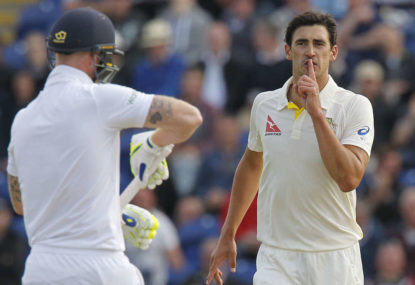On Friday night, ten minutes after Australia had been dismissed, the umpires and the Aussies were on the field, but the Pakistani batsmen were nowhere to be seen. So a radio broadcaster asked the question, “Can you be timed out before a ball has been bowled?”
The answer of course was no. That’s not how timed out works. And no sooner had the words been said than the Pakistani openers made their belated entry to the Gabba.
Timed out. It’s one of the more obscure forms of cricket dismissal.
Law 31 of the MCC Laws of Cricket states that an incoming batsman must be in a position to take guard within three minutes of the fall of the previous wicket. There’s a variation for T20 cricket, where the limit is 90 seconds.
Hence, the Pakistani openers were in the clear, as there hadn’t been a previous wicket; and in any event, they were less than three minutes late. No one has been dismissed timed out in any form of international cricket, and only five instances have ever happened at first-class level.
Every cricket trivia night is guaranteed to have the question of naming ten ways to be dismissed in cricket. Some are and common – Caught, bowled, LBW, stumped, run out; anyone who’s ever watched a cricket game has seen plenty them.
Hit wicket isn’t quite so common, but we see it occasionally.
A more obscure method of dismissal is handled the ball. This is covered by Law 33 of the Laws of Cricket. A batsman is dismissed handled the ball if they deliberately touch the ball with a hand that is not holding the bat, with an exemption if the batsman is doing it to avoid injury.
Only ten times in Test cricket and three times in one-day internationals has a batsman fallen this way. Most of the dismissals involved a batsman knocking the ball away to stop it hitting the wicket, but the dismissal of Andrew Hilditch in 1978/79 was controversial.
Late on a hot day, after a wayward throw towards the stumps, Hilditch picked up the ball and returned it to the bowler; only for the bowler to appeal and Hilditch to be dismissed.
Hilditch would go on to become an Australian vice-captain, and later chairman of selectors, but he’ll forever carry this rare form of dismissal in his Test record. Also dismissed in this way at Test level were Russell Endean, Mohsin Khan, Desmond Haynes, Graham Gooch, Steve Waugh, and Michael Vaughan.
Obstructing the field is another rare form of dismissal. Law 37 provides that a batsman is dismissed if they deliberately obstruct or distract the fielding team, such as by changing their course while running between the wickets to deflect a throw, or calling out to prevent a catch being taken.
Only once in Test cricket has a batsman been dismissed obstructing the field, in 1951. England’s Len Hutton top-edged the ball and it flew directly upwards. Thinking the ball would hit the stumps, Hutton hit the ball away, preventing the wicketkeeper from completing a catch.
Six batsmen have been dismissed obstructing the field in one-day internationals; four of the six being from Pakistan. Rameez Raja, Inzamam Ul-Haq, Mohammed Hafeez and Anwar Ali. Also out that way have been England’s Ben Stokes and India’s Mohinder Amarnath. Amarnath is also one of the three players to have been dismissed handled the ball in an ODI.
Probably the most obscure and certainly the rarest form of dismissal is Law 34, hit the ball twice. This states that a batsman is out if the ball, while in play, strikes any part of their person or is struck by the bat and then, before being touched by the fielder, the batsman deliberately hits the ball with the bat or any part of their person. The exemption is if they’re doing it to prevent the ball from hitting the stumps or to prevent injury.
No batsman has ever been dismissed hit the ball twice in any form of international cricket. Only a handful of instances at first-class level, mainly deep in the early historical days of the game, exist. The threat of dismissal seems to be enough to prevent anyone trying it on.
So your ten ways of getting out in cricket, for those ready to blitz their next trivia night, are: caught, bowled, LBW, stumped, hit wicket, run out, timed out, handled the ball, obstructing the field, and hit the ball twice.
There’s an 11th form of dismissal: retired out. Not retired hurt.
A batsman can retire hurt and return later, but if they choose to stop batting for any other reason, they can’t come back.
It’s happened twice at Test level, both in the same innings. Sri Lanka’s Marvan Atapattu with a score of 201 and Mahela Jayawardene on 150 withdrew from their innings to give other players a bat during a lopsided Test against Bangladesh, at Colombo in 2001.
Depending on the circumstances, it can be agreed that a player who retires is not out. This has happened once at Test level, when West Indies opener Gordon Greenidge dropped out of his innings to be with his critically ill daughter and it was agreed by all involved that he would be recorded as not out.
I’ve been involved in plenty of cricket in my time, played a bit (very badly) in my younger days, and attended more games than I care to count.
I’ve never seen, live or on TV, anyone dismissed timed out or hit the ball twice. If any of us ever do, we know we’re watching something that will earn a place in cricketing rarity.





























































































